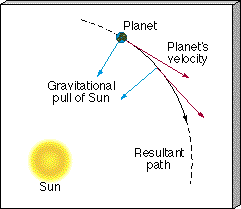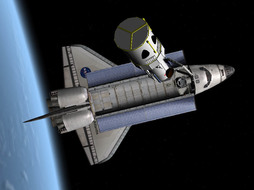|
Energy >>
|
3.4 - Orbital Motion
Objectives:
- To know Kepler’s three laws of planetary motion
- To be able to derive Kepler’s Third Law from first principles
- To be able to use these laws to describe orbital motion
- To be able to describe the behaviour of objects in orbit
|
Planets orbit the Sun in an almost circular path as they are subject to a force that is perpendicular to their motion. It is gravity that is causing this centripetal acceleration.
|
\[F_{centripetal}=F_{gravity}\]
\[F=\frac{mv^{2}}{r}=\frac{GMm}{r^{2}}\]
\[v^{2}=\frac{GM}{r}\]
\[v=\frac{2\pi r}{T}\]
Substituting gives:
\[T^2 = \frac{4 \pi^2}{GM} r^3\]
which is Kepler's Third Law of Planetary Motion.
|
ACTIVITY
Use the data found in the EXCEL spreadsheet of planetary data to verify Kepler's Third Law. You can go further by converting the units to base units (metres and seconds) and showing that the gradient of the linearised data will yield the mass of the Sun, \(M _\odot= 2.0 \times 10^{30}\,\text{kg}\). |
| ||||||
https://what-if.xkcd.com/58/ Orbital speed - for a brilliant description of the problems of achieving orbital speed compared to a sub-orbital 'lob'.
PhET Simulation: Gravity and Orbits. This is very useful and it is fun to switch between scales and play with changing the speed of orbiting satellites etc.
|
|
|
Advanced - Gravitational Potential Wells
Objectives:
|
Air resistance does slow orbits down eventually. There is not much air resistance in orbit, but enough that it has a tiny effect. This article is about the Chinese Space Station - 26 March 2018
Projects
Instead of a test, the assessment for this topic will be a project as well as the Past AP Questions and notes.
Projects to be a bare minimum of 4 pages (max 12pt, sensible font). Must be in your own words. Quote all resources that you use. The high scoring projects will demonstrate research, thoughts and good explanations. These are open-ended and you are free to run with them. It is expected that you will spend quite a few hours working on it. You can use ideas, images and data from simulations etc – but quote them
1. Measuring the World
How did Eratosthenes measure the radius of the Earth?How does his value compare to modern values? How do scientists do the same thing today?Is the Earth a sphere?
2. Models of the Solar System.
What were the different models of Solar System/Universe?What is retrograde motion and how did Copernicus explain it?What was the evidence that Galileo used to show that the Geocentric model was wrong?
3. Neutron Stars and Black Holes
What are they?!How are they formed?What evidence do we have that they actually exist?
4. Potential Wells
These are used to model gravity, can you explain them and show how they help?
5. What is Gravity?
Look at the different ideas and theories to explain what gravity is.
6. Orbits
Explain what an orbit is and also why it is that astronauts float in the space station?What are the different orbits (polar and geostationary) and what are they used for?
7. The Effects of the Moon
Eclipses and Tides.Why are the tides different?Why don’t we have eclipses every month?What is the difference between the lunar months and why? (27 and 29 days)
8. Ellipses
What is an ellipse? How can you draw it?How are comet’s orbits so different from a planet’s?What are comets and what do they look like?How does the speed vary during the orbit and why?
9. Inter-planetary Travel
Just how hard is it to go to another world or moon?What is a gravity assist?What are the furthest probes that we have sent into space?What are the problems involved?Show any calculations that you make.
Projects to be a bare minimum of 4 pages (max 12pt, sensible font). Must be in your own words. Quote all resources that you use. The high scoring projects will demonstrate research, thoughts and good explanations. These are open-ended and you are free to run with them. It is expected that you will spend quite a few hours working on it. You can use ideas, images and data from simulations etc – but quote them
1. Measuring the World
How did Eratosthenes measure the radius of the Earth?How does his value compare to modern values? How do scientists do the same thing today?Is the Earth a sphere?
2. Models of the Solar System.
What were the different models of Solar System/Universe?What is retrograde motion and how did Copernicus explain it?What was the evidence that Galileo used to show that the Geocentric model was wrong?
3. Neutron Stars and Black Holes
What are they?!How are they formed?What evidence do we have that they actually exist?
4. Potential Wells
These are used to model gravity, can you explain them and show how they help?
5. What is Gravity?
Look at the different ideas and theories to explain what gravity is.
6. Orbits
Explain what an orbit is and also why it is that astronauts float in the space station?What are the different orbits (polar and geostationary) and what are they used for?
7. The Effects of the Moon
Eclipses and Tides.Why are the tides different?Why don’t we have eclipses every month?What is the difference between the lunar months and why? (27 and 29 days)
8. Ellipses
What is an ellipse? How can you draw it?How are comet’s orbits so different from a planet’s?What are comets and what do they look like?How does the speed vary during the orbit and why?
9. Inter-planetary Travel
Just how hard is it to go to another world or moon?What is a gravity assist?What are the furthest probes that we have sent into space?What are the problems involved?Show any calculations that you make.
Energy >>
Other Resources
|
Orbiter. This is very sophisticated and highly addictive computer game, based on real physics and real data from a variety of rocket launches - e.g Mercury and the Space Shuttle. It does require a bit of time to play though!
|
|
|
|

